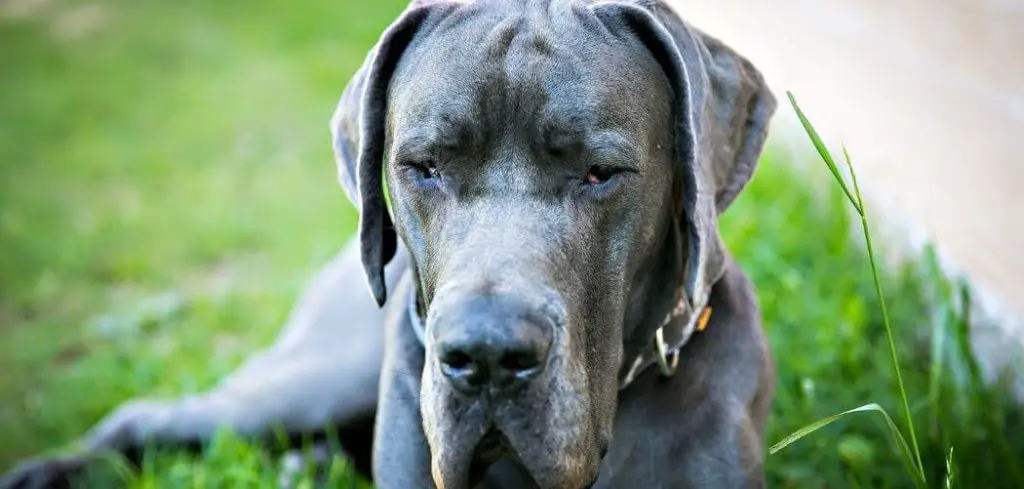As dogs age, their faces begin to change in noticeable ways. Gray hairs may appear around the muzzle, their eyes might look different, and the skin can loosen or sag.
While some changes are simply cosmetic, others may be signs of underlying health issues that need attention.
We outline the common facial changes in old dogs, and when to seek veterinary help.
Old Dog Face Changes
The most common reasons for changes in an old dog face include natural aging, dental disease, vision problems, skin conditions, and even neurological issues. These changes can range from harmless cosmetic signs of seniority to more serious conditions that impact your dog’s comfort and well-being.

Common Old Dog Face Changes
Natural Aging
One of the most obvious changes in an old dog face is the appearance of gray or white hairs, especially around the muzzle and eyebrows.
This graying is usually harmless and a natural sign of aging, just like in people. You may also notice loose skin, drooping lips, or a generally softer appearance in the facial muscles as tone decreases with age.
These changes do not usually cause discomfort, but they do reflect your dog’s stage of life and remind owners to pay closer attention to health and comfort.
Read more: Old Dog Eyes Issues (Why it happens and what you can do)
Dental Disease
Dental disease is extremely common in older dogs and can dramatically affect the face.
When teeth or gums are infected, you may see swelling on one side of the face, bad breath, or a reluctance to eat. In severe cases, abscesses can create visible lumps or draining tracts on the muzzle.
This is not just a cosmetic issue — untreated dental infections can spread to other parts of the body and cause significant pain.
Eye Problems
Eye issues often show up in the face and are common in older dogs. Cloudiness in the eyes may indicate nuclear sclerosis (a normal age change) or cataracts, which can affect vision.
You may also notice squinting, discharge, or a sunken appearance around one or both eyes. In some cases, bulging of the eye can be linked to tumors or severe infections.
Because eye health directly affects quality of life, any facial change related to the eyes should be taken seriously.
Related: Old Dog Face Twitching (Here’s why)
Skin Lumps and Growths
As dogs age, lumps, bumps, and warts often appear on the face. These may be benign growths like lipomas or sebaceous adenomas, but they can also be more concerning tumors.
Owners might notice raised areas on the muzzle, lips, or around the eyes. While many of these are harmless, it is impossible to know without veterinary evaluation.
Facial lumps should always be checked because early detection can make a big difference in treatment outcomes.
Facial Paralysis or Neurological Issues
Some old dogs develop weakness or paralysis of the facial muscles. This can cause drooping lips, an uneven expression, or difficulty closing one eye.
These changes may result from nerve damage, ear infections, or underlying neurological disease.
Facial paralysis can impact eating, blinking, and even drooling patterns, making it more than just a cosmetic change. Veterinary evaluation is essential if you notice sudden facial changes.
Sinus or Nasal Problems
Chronic sinus infections, dental disease, or tumors in the nasal cavity can cause swelling, discharge, or asymmetry of the old dog face.
You might see one side of the muzzle enlarge or notice nasal discharge that doesn’t resolve. In some cases, nosebleeds may also be present.
These conditions can be serious and require medical attention, especially if changes happen suddenly.
What to Do If Your Dog Has Changes on Their Face
If you notice changes in your old dog’s face, start by observing closely. Some things, like graying fur, are harmless and part of aging. But swelling, asymmetry, or sudden changes are red flags.
At home, you can keep your dog comfortable by maintaining good dental hygiene, gently cleaning around the eyes and nose, and monitoring for new lumps or bumps. A healthy diet, regular grooming, and senior-friendly vet visits also help slow down the effects of aging.
Avoid assuming that all changes are “just old age.” Many treatable issues can present as facial changes, so keeping track of when they appear and how they progress is important.
When to Call or Visit Your Vet
You should contact your vet if you notice swelling, lumps, discharge from the eyes or nose, uneven facial movement, or sudden changes in your dog’s expression.
Persistent bad breath, refusal to eat, or pain when chewing also need urgent evaluation since dental problems are extremely common.
Any sudden drooping of the face, eye changes, or nosebleeds should be treated as urgent. A veterinarian can determine whether the cause is minor or something more serious.
Read more: Old Dog Eyes Cloudy (What cloudy eyes mean in seniors)
Key Takeaway
An old dog face often tells the story of aging, but not all changes are purely cosmetic. While gray hairs and softer features may be harmless, swelling, lumps, eye changes, or drooping can signal serious health problems.
Paying attention to your dog’s facial changes is a valuable way to catch medical issues early. With regular checkups and prompt care, you can help your senior dog stay comfortable and healthy as they age gracefully.
